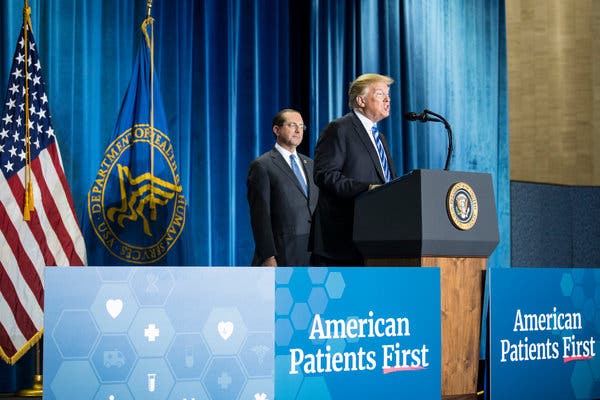Trump Executive Order Targets High Drug Prices

Table of Contents
Key Provisions of the Executive Order
The Trump administration's executive order on high drug prices proposed several key measures to rein in escalating costs. These provisions aimed to increase transparency, leverage international pricing models, and empower Medicare to negotiate drug prices – a long-sought goal of many healthcare advocates.
-
International Price Indexing: This measure proposed referencing drug prices in other developed countries to inform pricing decisions in the US. The argument was that if a drug is significantly cheaper in Canada or Europe, the US price should reflect this international benchmark, thereby lowering costs for American consumers. This strategy aimed to curb the perceived practice of price gouging by pharmaceutical companies.
-
Most-Favored-Nation Pricing: This policy considered tying US drug prices to the lowest prices negotiated by other countries. The idea was that pharmaceutical companies would be obligated to offer the best price they provide to any country to the United States, eliminating the potential for price discrimination. This policy was highly contentious due to its potential impact on pharmaceutical innovation.
-
Transparency Requirements for Pharmaceutical Companies: The executive order also focused on increasing transparency within the pharmaceutical industry. By requiring greater disclosure of pricing and cost structures, the goal was to expose pricing practices and encourage more competitive pricing. This measure aimed to provide more information to consumers and policymakers, empowering them to make informed decisions.
-
Negotiation of Drug Prices by Medicare: A cornerstone of the executive order was the push to allow Medicare, the federal health insurance program for seniors and people with disabilities, to directly negotiate drug prices with pharmaceutical companies. This is a significant step given that Medicare is a massive purchaser of drugs. Successful negotiation could lead to significant cost savings, impacting both the government budget and patient out-of-pocket costs.
Impact on Pharmaceutical Companies
The executive order's proposed measures presented substantial challenges to pharmaceutical companies. The potential implications included significant financial and operational adjustments:
-
Reduced Profit Margins: The primary concern for pharmaceutical companies was the threat of reduced profit margins. Price controls and increased price transparency could significantly cut into their revenue streams, especially for high-priced brand-name drugs.
-
Impact on Research and Development (R&D): Many pharmaceutical companies argued that reduced profitability could negatively impact their investment in research and development of new drugs. The fear was that lower profits would discourage innovation, potentially hindering the development of life-saving medications.
-
Potential Legal Challenges: The executive order faced considerable opposition from the pharmaceutical industry, leading to predictions of legal battles and court challenges. Pharmaceutical companies were expected to argue that the government’s intervention infringed on their rights and stifled free-market principles.
Effects on Consumers and Patients
The potential effects of the executive order on consumers and patients were complex and presented both benefits and drawbacks:
-
Lower Out-of-Pocket Costs: The most significant potential benefit was the reduction in out-of-pocket expenses for patients. Lower drug prices would make medications more affordable, potentially improving patient adherence and health outcomes.
-
Increased Access to Medications: Lower prices could lead to increased access to medications for many Americans currently unable to afford essential drugs. This could be especially impactful for individuals with chronic conditions requiring long-term medication.
-
Potential Drug Shortages: Conversely, a significant concern was the potential for drug shortages. If the reduced profitability caused by the executive order led pharmaceutical companies to reduce production or discontinue certain drugs, patients could face significant challenges in accessing needed medications.
Political and Legal Ramifications
The Trump administration's executive order on high drug prices ignited a fierce political debate and triggered numerous legal challenges.
-
Political Opposition: The order faced considerable opposition from Republicans and Democrats alike. While many supported the goal of reducing drug costs, concerns about government overreach and potential negative impacts on innovation sparked intense political debate.
-
Legal Battles and Court Challenges: The pharmaceutical industry launched significant legal challenges to the executive order, arguing that the measures were unconstitutional and infringed upon their rights. These legal battles continue to shape the landscape of drug pricing policy in the United States.
-
Long-Term Effects on Healthcare Policy: The long-term impact of the executive order remains uncertain. The outcome of the legal challenges and the political response to the order's provisions will significantly influence future healthcare policy debates around prescription drug costs and government regulation of the pharmaceutical industry.
Assessing the Long-Term Effects of Trump's Executive Order on High Drug Prices
The Trump administration's executive order represented a bold attempt to tackle the issue of high drug prices in the US. While its provisions aimed to increase transparency, leverage international pricing, and empower Medicare negotiation, the order faced significant political and legal challenges. The potential impacts on pharmaceutical companies, consumers, and the broader healthcare system remain a topic of ongoing debate. The executive order highlighted the complex interplay between the pharmaceutical industry, government regulation, and patient access to life-saving medications. To stay informed about the ongoing impact of this executive order and the future of prescription drug pricing, we encourage you to continue researching the topic and following relevant developments in healthcare policy. [Link to a relevant resource, e.g., a government website or reputable news source].

Featured Posts
-
 Gaza Hostage Crisis A Lingering Nightmare For Families
May 13, 2025
Gaza Hostage Crisis A Lingering Nightmare For Families
May 13, 2025 -
 Uppgifter Vem Tar Oever Atalanta
May 13, 2025
Uppgifter Vem Tar Oever Atalanta
May 13, 2025 -
 Hamas Ramadan Deadline Will Edan Alexander And Other Captives Be Freed
May 13, 2025
Hamas Ramadan Deadline Will Edan Alexander And Other Captives Be Freed
May 13, 2025 -
 The Influence Of Classic Doom On Contemporary Game Developers
May 13, 2025
The Influence Of Classic Doom On Contemporary Game Developers
May 13, 2025 -
 Spring Break Fun For Kids Planning The Perfect Vacation
May 13, 2025
Spring Break Fun For Kids Planning The Perfect Vacation
May 13, 2025
